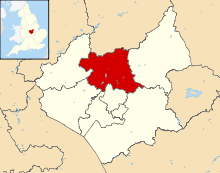Quorn, Leicestershire
Quorn is a village in Leicestershire, England, near the university town of Loughborough. The name was shortened from Quorndon in 1889, to avoid postal difficulties owing to its similarity to the name of another village, Quarndon, in neighbouring Derbyshire.[1] The village's original name is thought to be derived from the Old English cweorndun, meaning "hill (dun) where millstones (cweorn) are obtained".
| Quorn | |
|---|---|
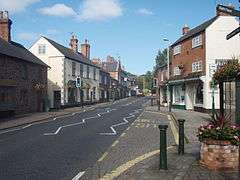 Quorn High Street | |
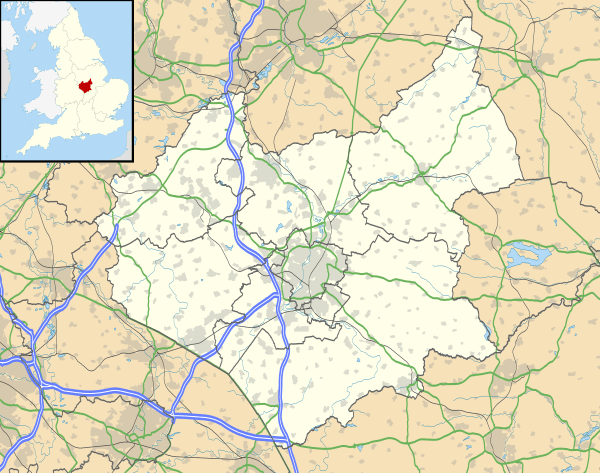 Quorn Location within Leicestershire | |
| Population | 5,177 (2011) |
| OS grid reference | SK561164 |
| District |
|
| Shire county | |
| Region | |
| Country | England |
| Sovereign state | United Kingdom |
| Post town | Loughborough |
| Postcode district | LE12 |
| Dialling code | 01509 |
| Police | Leicestershire |
| Fire | Leicestershire |
| Ambulance | East Midlands |
| UK Parliament | |
History
The first known evidence of the village is in the Lincoln Episcopal Registers for 1209–1235, as Quernendon. Other variations of the village name over the centuries include Querne, Quendon, Querendon, Quarendon, Qaryndon, Querinden, Querondon, and Quernedon.[2]
The quarrying of stone in Quorn began at a very early age at Buddon Wood, on the edge of the parish. Granite millstones were quarried in the early Iron Age, and under the Romans stone was quarried for building in Leicester. Some of the larger millstones can still be seen in the area, however these days they are either used as garden ornaments, or worked into seats or slabs.
Quorn Hall, off Meynell Road on the eastern edge of the village, was built for the Farnham family in about 1680.[3] It became the home of renowned fox hunter Hugo Meynell in 1753. He established his pack of hounds there, where it continued under later masters until 1905, thus giving a name to the famous Quorn Hunt.[4] Three Royal Navy ships have been named HMS Quorn after the hunt.[5]
The meat substitute Quorn derives its name from this village, and began production in 1985.[6]
World Wars
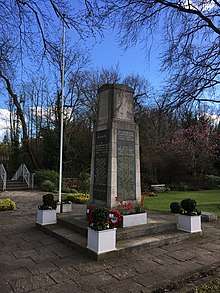
96 men from Quorn lost their lives in the two World Wars (77 in World War I and 19 in World War II).[7] A cenotaph in Quorn's Memorial Gardens honours these men.
Quorn Camp was established on the grounds of Quorn House during World War II. It was used as a PoW camp[8][9] and was also host to a number of the United States Army 82nd Airborne Division's 505th Parachute Infantry Regiment.[10] These paratroopers were involved in liberating the town of Sainte-Mère-Église, in Normandy, France, on the morning of D-Day and included Pvt. John Marvin Steele who famously became caught on the town's church spire.[11] This incident is today commemorated with a dummy paratrooper and parachute attached to the church in Sainte-Mère-Église.
A number of American veterans come back to Quorn, particularly every tenth anniversary of the D-Day landings, to remember their time in Quorn and their comrades who did not return.[12]

There is a plaque commemorating the lost US servicemen in Quorn's Memorial Gardens, upon which a poppy wreath is placed each year on Remembrance Sunday. There is also an avenue of lime trees in Stafford Orchard (the village park) in remembrance of those American soldiers that died, together with a plaque.[10]
Today
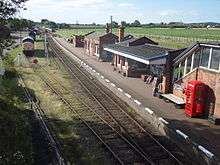
Quorn is built around the old A6 road which runs through the centre of the village. On 28 October 1991 a dual carriageway bypass opened taking the A6 away to the north-eastern edge of the village.[13]
The village has a railway station called "Quorn and Woodhouse", shared with the neighbouring hamlet of Woodhouse, which was on the national Great Central Railway network. The station is now on the preserved Great Central Steam Railway. Numerous royal visitors have disembarked at the station to take part in the Quorn Hunt, including the Prince of Wales (later King Edward VIII).[14] As well as being a site of historical and cultural interest throughout the year, the station hosts a fireworks display on the Bonfire weekend. The station is also home to a small vintage tea room at the 'bridge-most' end of the platform, and also the Butler Henderson Café in the main car park.[15]
Sarson Street, running adjacent to Rawlins Community College, features many 19th Century terraced cottages, formerly those of framework knitters. Framework knitting was a major local industry until the onset of major mechanisation, and the cottages along this road display certain features typical of such an activity. Large windows for example were intended to allow in the necessary amount of light by which to work.
M. Wright & Sons Ltd have been manufacturing fabrics at Quorn Mill, on Leicester Road, since 1870. Originally producing fabrics for the footwear and corset trades, the factory now produces high technology textiles for various industries including military, aerospace and leisure.[16]
"The Banks" area of the village is an ornate paved area with seating, designed to resemble the letter 'Q' when seen from the air.
The village prides itself on its green spaces, and more evidence of this can be seen with the opposition to proposed development at Caves field. This is a large cricket pitch with pavilion Where Quorn Cricket Club play during the season, near the centre of Quorn, which was the focus of interest from a housing development company. Objection was widespread, not only at the prospect of losing the cricket field but also due to the threat to a neighbouring wetland ecosystem, considered valuable by environmentalists and the village population.
In the past few years, efforts have been made to cater for the local young people. These have resulted in a half pipe being built next to the basketball court on Stafford Orchard, and a green shelter erected on the same site. Stafford Orchard is the large park, with a shaded area by the stream, youngster's play area and half pipe now appeals to people of all ages. Examples of how the Stafford Orchard contributes to the village can be seen at the large and successful Mayday celebrations, as well as the local pub football matches occasionally held there.
In 2016, Quorn was awarded one of the top 5 places in the UK to bring up a family in a survey conducted by Estate Agents, Leaders[17]
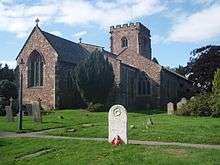
The Church of St Bartholomew and Farnham Chapel is a Grade I listed building.[18]
Quorn House, off Meeting Street, is a grade II listed building, built in 1820, and was the seat of the Farnham family since c1260 until 1993 when it was sold to fitness instructor Rosemary Conley, whose business occupied the building until 2015.[19][20] Quorn House and the surrounding 120 acres of parkland was then purchased by Tarmac, operators of Mountsorrel Quarry, who have utilised the building as office space.[21]
Education
St Bartholomew's Primary School is a Church of England controlled school for foundation-age children through year 6.[22] In the centre of the village, adjacent to St Bartholomew's Church, is Rawlins Academy, a secondary school which goes from years 7 to Sixth form where they got a good in the 2017 Ofsted report and outstanding in the Sixth form. The school also provides adult education and leisure classes.[23] This is on the site of the Thomas Rawlins Grammar School for Girls.
Loughborough Grammar School have a number of sports pitches on the edge of the village.[24]
Population
The 2011 census showed Quorn's population to be 5,177 (an increase from 4,961 in 2001), composed of 2,524 males and 2,653 females.[25]
Parish and boundaries
The full name, Quorndon, is still the official name of the civil parish.
The River Soar forms much of Quorn's eastern boundary with the village of Barrow upon Soar and captures Pilling's Lock and parts of the Grand Union Canal, Midland Main Line railway and A6 dual carriageway. The southern boundary, with the neighbouring villages of Mountsorrel, Rothley and Swithland, encompasses Buddon Wood, Mountsorrel Quarry and part of Swithland Reservoir. The Great Central Railway makes up most of western boundary with the village of Woodhouse. The northern boundary captures Bull in the Hollow Farm and is shared with the hamlet of Woodthorpe and the town of Loughborough.[26]
Notable residents
- Jane Hunt, MP for Loughborough (Conservative)[27]
- Andy Reed, former MP for Loughborough (Labour)[28]
- Peter Jones, FA Premier League referee[29]
- Gordon Banks, the 1966 FIFA World Cup winning goalkeeper
- Hugo Meynell of Quorndon Hall, pioneer of fox hunting
- Rosemary Conley, businesswoman, author and broadcaster on exercise and health[30]
- David Gower, former England cricketer and current cricket commentator for Sky Sports, was educated for a time in Quorn,[31] at the Old Primary School.
Quorn, Australia
The outback township of Quorn, South Australia, was named in May 1878 by Governor William Jervois of the then Province of South Australia after Quorn, Leicestershire – the birthplace of his private secretary, Mr J. H. B. Warner.[32]
See also
- Quorn Football Club
- Rawlins Community College
References
- "Archived copy". Archived from the original on 22 February 2014. Retrieved 15 February 2014.CS1 maint: archived copy as title (link)
- "See page 5" (PDF). Retrieved 26 July 2013.
- "Quorn Hall". British Listed Buildings.
- William Charles Arlington Blew, The Quorn hunt and its masters (London: John C. Nimmo, 1899): chapter Mr H. Meynell, 1753–1800
- "HMS Quorn". Royalnavy.mod.uk. Archived from the original on 20 September 2011. Retrieved 26 July 2013.
- Oxford Dictionary of English (2010), page 1459
- "Archived copy". Archived from the original on 26 October 2009. Retrieved 8 November 2009.CS1 maint: archived copy as title (link)
- http://www.english-heritage.org.uk/content/publications/docs/prisoner-of-war-camps.pdf
- Rogers, Simon (8 November 2010). "Every prisoner of war camp in the UK mapped and listed | News | guardian.co.uk". Guardian. Retrieved 26 July 2013.
- "US 82nd Airborne Division - The Quorn Village On-line Museum". Quornmuseum.com. Archived from the original on 15 July 2011. Retrieved 26 July 2013.
- "See photographs". 505rct.org. Archived from the original on 22 February 2014. Retrieved 26 July 2013.
- "Revisiting Quorn". CBS News. 5 December 2007. Retrieved 26 July 2013.
- "Pages 5 & 6" (PDF). Dft.gov.uk. Archived from the original (PDF) on 8 February 2010. Retrieved 26 July 2013.
- http://www.railwayarchive.org.uk/stories/pages.php?enum=LE128&pnum=6&maxp=9
- https://www.gcrailway.co.uk/station-facilities/butler-henderson-cafe-quorn-woodhouse/
- "A Family owned Woven Narrow Fabrics company , M Wright & Sons Ltd, Quorn". Mwright.co.uk. Retrieved 26 July 2013.
- https://www.leicestermercury.co.uk/news/property/leicestershire-village-named-one-best-153509
- "Church of St Bartholomew and Farnham Chapel, Church Lane, Quorn - Listed Buildings - Charnwood Borough Council". Charnwood.gov.uk. 1 June 1966. Retrieved 26 July 2013.
- http://www.charnwood.gov.uk/listed_buildings/quorn_house_meeting_street_quorn
- "Archived copy". Archived from the original on 27 December 2016. Retrieved 26 December 2016.CS1 maint: archived copy as title (link)
- http://www.tarmac.com/mountsorrel-quarry/about#history
- "Saint Bartholomew's Primary School, Quorn Village, England". St-bartholomews.leics.sch.uk. Archived from the original on 8 September 2012. Retrieved 26 July 2013.
- "Home - Rawlins". Rawlinscollege.org.uk. 27 February 2012. Archived from the original on 8 September 2012. Retrieved 26 July 2013.
- "Sports | Loughborough Grammar School". Lesgrammar.org. 26 September 2011. Archived from the original on 3 July 2013. Retrieved 26 July 2013.
- http://www.nomisweb.co.uk/census/2011/ks101ew
- OS Explorer Map 246. 2005.
- https://www.loughboroughconservatives.com/Aboutus
- http://www.andyreed.net/andys-bio.html#heading-119292
- https://www.lboro.ac.uk/service/publicity/degree_days/degree_2000/jones.html
- Rosemary Conley
- "Wisden – David Gower". Cricinfo.com. Retrieved 26 July 2013.
- https://web.archive.org/web/20050415025615/http://quorndon-mag.org.uk/archive/autumn2003/twoquorns.html
External links
| Wikimedia Commons has media related to Quorn, Leicestershire. |
